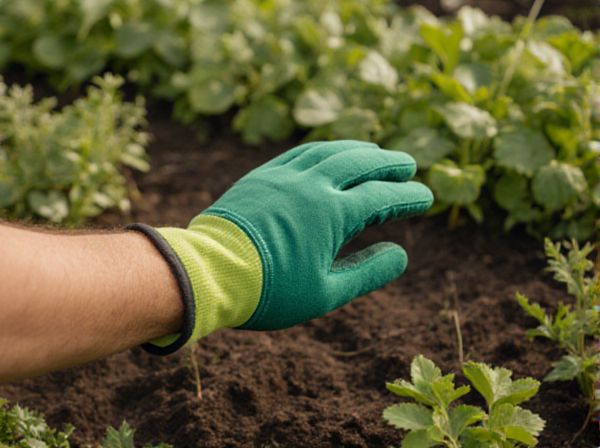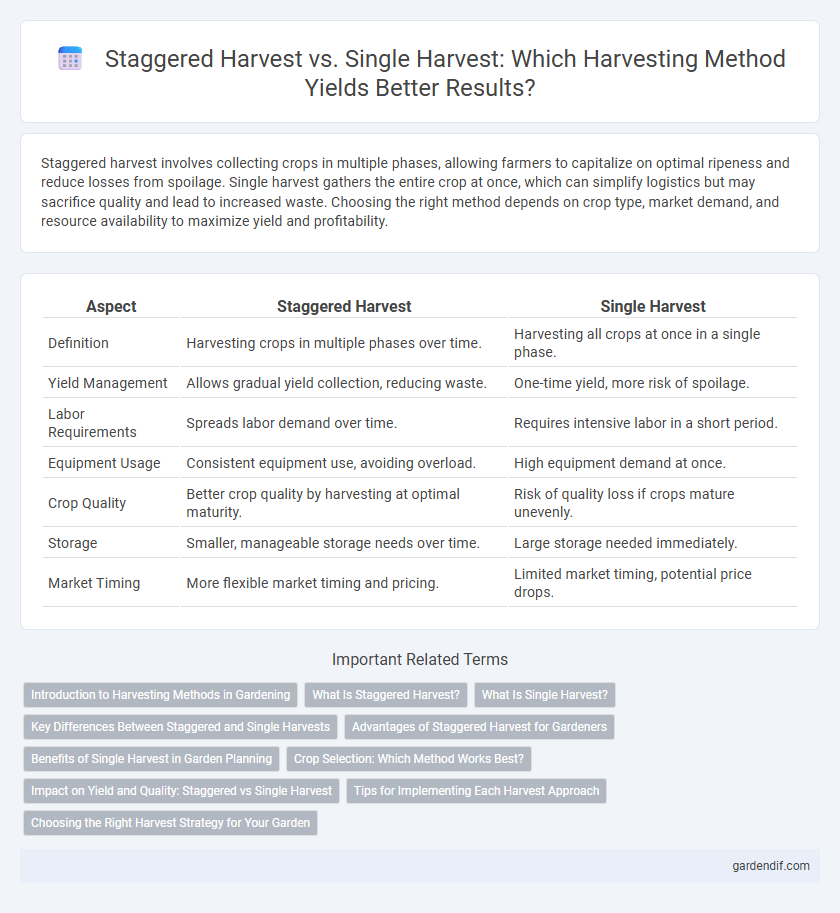
Staggered Harvest vs Single Harvest Illustration
Staggered harvest involves collecting crops in multiple phases, allowing farmers to capitalize on optimal ripeness and reduce losses from spoilage. Single harvest gathers the entire crop at once, which can simplify logistics but may sacrifice quality and lead to increased waste. Choosing the right method depends on crop type, market demand, and resource availability to maximize yield and profitability.
Table of Comparison
| Aspect | Staggered Harvest | Single Harvest |
|---|---|---|
| Definition | Harvesting crops in multiple phases over time. | Harvesting all crops at once in a single phase. |
| Yield Management | Allows gradual yield collection, reducing waste. | One-time yield, more risk of spoilage. |
| Labor Requirements | Spreads labor demand over time. | Requires intensive labor in a short period. |
| Equipment Usage | Consistent equipment use, avoiding overload. | High equipment demand at once. |
| Crop Quality | Better crop quality by harvesting at optimal maturity. | Risk of quality loss if crops mature unevenly. |
| Storage | Smaller, manageable storage needs over time. | Large storage needed immediately. |
| Market Timing | More flexible market timing and pricing. | Limited market timing, potential price drops. |
Introduction to Harvesting Methods in Gardening
Staggered harvest involves picking crops at multiple intervals as they ripen, allowing for fresher produce and extended yield periods. Single harvest collects all mature crops at once, maximizing labor efficiency but potentially leading to quicker spoilage. Gardeners choose methods based on crop type, storage capacity, and consumption needs to optimize freshness and productivity.
What Is Staggered Harvest?
Staggered harvest involves collecting crops in multiple phases over a growing season, allowing for optimal ripeness and quality at each interval. This method reduces the risk of crop loss due to weather or pests and improves overall yield efficiency compared to a single harvest. By timing harvests according to crop maturity, farmers achieve better resource management and market flexibility.
What Is Single Harvest?
Single harvest is an agricultural practice where crops are collected all at once when they reach full maturity, ensuring uniformity in yield and quality. This method is commonly used for crops like wheat, corn, and soybeans, where harvesting at peak ripeness maximizes grain quality and reduces losses. Single harvest simplifies labor and machinery scheduling but may risk yield reduction if weather conditions deteriorate before harvest completion.
Key Differences Between Staggered and Single Harvests
Staggered harvest involves collecting crops at multiple intervals to optimize yield quality and manage labor efficiently, while single harvest gathers the entire crop at once, typically maximizing operational simplicity. Key differences include timing, resource allocation, and crop maturity management--staggered harvest sustains continuous market supply and reduces spoilage risk by targeting peak ripeness. Single harvest suits crops with uniform maturity but may face challenges with post-harvest storage and fluctuating market demand.
Advantages of Staggered Harvest for Gardeners
Staggered harvest allows gardeners to enjoy fresh produce over an extended period, reducing the risk of crop spoilage and waste. This method enhances pest and disease management by minimizing the concentration of vulnerable plants at one time. It also promotes consistent income or supply for small-scale farmers and home gardeners by distributing workload and yield throughout the growing season.
Benefits of Single Harvest in Garden Planning
Single harvest in garden planning maximizes resource efficiency by allowing concentrated labor and machinery use, reducing overall operational costs. It simplifies scheduling and crop management, ensuring uniform crop maturity and optimal timing for market delivery. This method enhances yield predictability and quality consistency, supporting better inventory control and customer satisfaction.
Crop Selection: Which Method Works Best?
Staggered harvest optimizes crop selection by allowing multiple pickings at peak ripeness, enhancing quality and yield for perishable crops like berries and leafy greens. Single harvest suits crops with uniform maturation such as grains and root vegetables, simplifying labor and reducing field time. Choosing the best method depends on crop type, market demand, and post-harvest handling capabilities to maximize profitability and freshness.
Impact on Yield and Quality: Staggered vs Single Harvest
Staggered harvest allows crops to be picked at their individual peak maturity, enhancing overall yield by minimizing losses from overripe or underripe produce and improving quality through fresher, more consistent produce. In contrast, single harvest often results in variable crop maturity, potentially reducing yield due to early or late picks and impacting quality with increased incidence of spoilage or inconsistent taste and texture. Optimizing harvest timing through staggered approaches leads to better market value and resource efficiency.
Tips for Implementing Each Harvest Approach
Staggered harvest requires careful planning of planting schedules and crop varieties to ensure continuous yield and optimal resource use, while monitoring crop maturity is essential for timely picking. Single harvest demands precise timing and coordination to harvest all crops simultaneously, minimizing post-harvest losses and simplifying labor allocation. For both methods, investing in proper equipment and skilled labor enhances efficiency and quality of the produce.
Choosing the Right Harvest Strategy for Your Garden
Staggered harvest allows for continuous crop production and fresher yields by planting in intervals, which reduces waste and spreads out labor demands over time. Single harvest provides a large, concentrated yield ideal for preserving and bulk processing but requires substantial storage and labor at once. Gardeners should evaluate space, crop type, and usage needs to select the harvest strategy that maximizes efficiency and freshness.
Staggered Harvest vs Single Harvest Infographic

 gardendif.com
gardendif.com